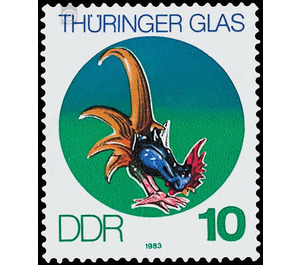Thuringian glass - Germany / German Democratic Republic 1983 - 10 Pfennig
Theme: Art & Culture
| Country | Germany / German Democratic Republic |
| Issue Date | 1983 |
| Face Value | 10.00 |
| Color | multi-colored |
| Perforation | K 14 |
| Printing Type | Rotogravure 2 |
| Stamp Type | Postage stamp |
| Item Type | Stamp |
| Chronological Issue Number | 2577 |
| Chronological Chapter | GER-DDR |
| SID | 100566 |
| In 26 Wishlists | |
Thüringer Glas With the illustrations of Thüringer Glas, the Ministry of Posts and Telecommunications of the German Democratic Republic publishes four multicolored special postage stamps. Special cancellation from 8 November 1983 to 7 January 1984 Thuringian Glass Lauscha is known as the center of Thuringian glassmaking. Especially sought-after are the artisan glasses, which are produced in the VEB glass art (Thuringia). Delicate vases, ornate stemmed glasses, candle holders, colorful brandy glasses or heavy glassware made of colored or crystal glass reflect a high degree of craftsmanship and a sure feeling of the glass designer for the special qualities of the material glass. Both in glass and in the lamp-blown products, craftsmanship and artistic design are organically interlinked, thus establishing Lauscha's reputation as a city of glassblowers. In 1597, the first glassworks in Lauschatal was built, which the glassmakers Christoph Müller and Heinz Greisner built up. Hand-blown balm bottles and Butzenscheiben were among their first metallurgical products. Striking for them was the greenish color of the so-called forest glass, which was due to the rich iron content. Experienced glassmakers today master the art of free-form design. Without forms, they manage to create glass products of peculiar charm through skilful rotational movements. Especially with these products, the material of glass comes in its heaviness and the flowing forms particularly to advantage. An example of this is the bowl on the 20-pfennig value. Over the centuries, knowledge and experience passed down from generation to generation. In the 18th century, in and around Lauscha, in addition to the pure ironwork with the glassmaker's whistle, the "work in front of the lamp" developed in a unique way: the lamp-blown, free-form "Thüringer Glas" first appeared, resulting in glass tubes and glass rods From the primitive oil lamp of the time, the now common all-gas appliance developed, with which, in contrast to earlier, even larger workpieces can be processed and designed, thus developing new techniques, the craftsmanship and design possibilities Thread glasses, mosaic glasses, glasses with enclosed decorations - delicate, delicate shapes that are very specific to the Thuringian glass art. "The 70-pfennig value and the 25-pfennig value show bowl and vase of colored glass tubes" in front of the lamp "mouthblown and hand deformed. This is how younger and older glass artists have come together to further perfect the special technique of figurative glass and to reintroduce old, almost forgotten techniques. An example is the game cock on the 10-pfennig value. From a massive glass rod figures of the animal and fairy tale world are formed "in front of the lamp". For the glass blowing today applies particularly: Only who masters the manual ability effortlessly, has room for the artistic imagination. Thuringian glass art today combines century-old craftsmanship tradition and new progressive craftsmanship.


